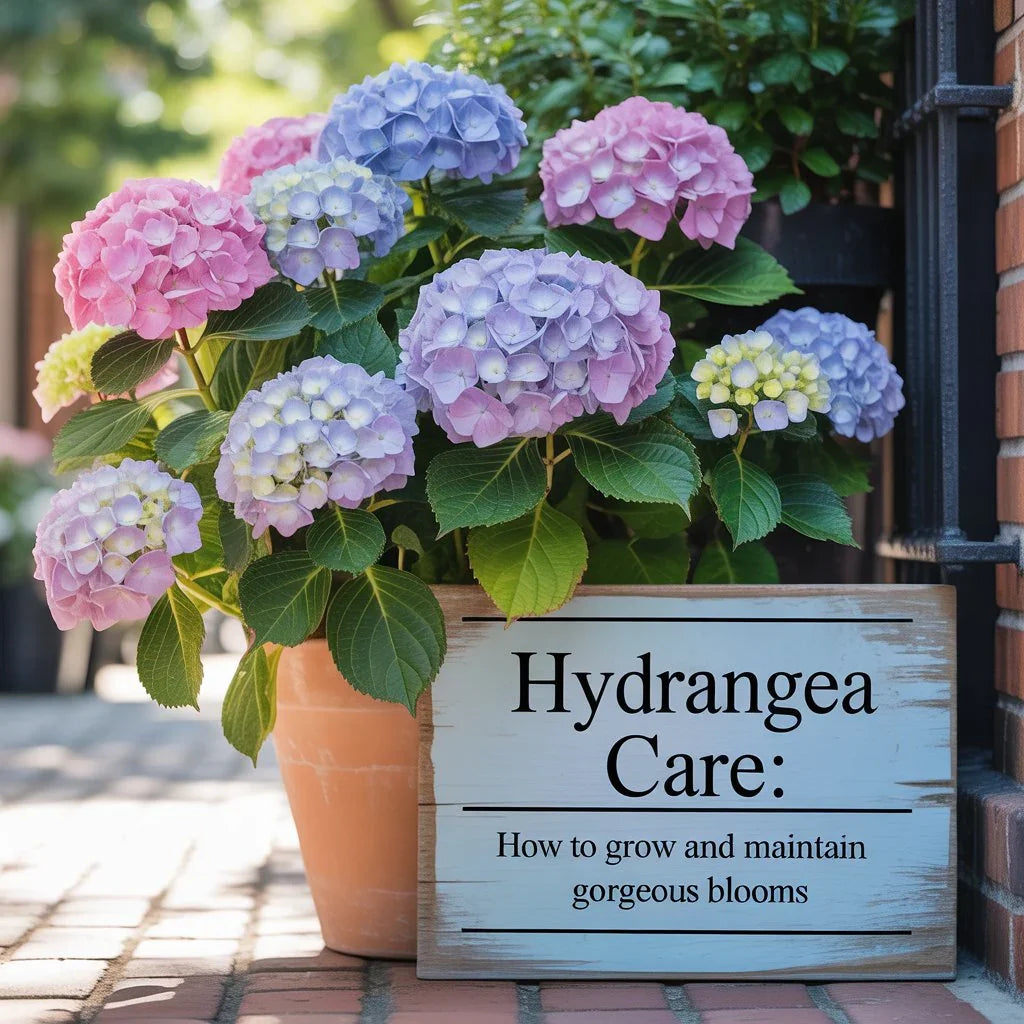
Hydrangea Care: How to Grow and Maintain Gorgeous Blooms in NYC
Share
Hydrangeas hold a charm few flowers can rival. Their dramatic, cloud-like blooms transform quiet corners into romantic hideaways, bringing a timeless beauty to even the most modest city gardens. But caring for them in a dynamic environment like New York City comes with its own unique challenges—from rooftop heat to shaded backyards and everything in between.
This guide dives deep into the real-world know-how you need to grow, nurture, and enjoy hydrangeas in an urban climate. Whether you're a first-time gardener or a seasoned green thumb, you'll find practical insights that make all the difference.
How to Care for Hydrangeas in NYC
Hydrangeas aren't difficult to grow, but they do demand attention to detail. In a city like New York, the first rule is to match your hydrangea variety with your growing space. The most reliable varieties for our Zone 7 climate include mophead, lacecap, and panicle hydrangeas.
Plant them in soil that drains well but retains moisture, and enrich it with organic compost to boost nutrients. Pay close attention to pH: acidic soil will bring out blue hues, while alkaline soil shifts the blooms toward pink. Consistent watering is key during dry spells, and a layer of mulch will help lock in moisture and keep the roots cool.
How to Grow Hydrangeas from Scratch
Start with strong, nursery-raised plants for the best results. Hydrangeas do best when planted in early spring or fall, giving them time to settle in before extreme temperatures arrive.
Choose a planting location with morning sunlight and afternoon shade. Prep the soil by loosening it at least 12 inches deep and mixing in compost. Hydrangeas need space, so give each plant a radius of at least three feet to encourage air flow and avoid disease.
Once planted, water thoroughly and continue to water regularly until the plant is well established.
How to Plant Hydrangeas the Right Way
When you're ready to plant, dig a hole that's twice the width of the root ball but no deeper. Gently untangle any compacted roots and set the plant so the top of the root ball is flush with the ground.
Fill in the hole with enriched soil, tamp it down lightly, and give it a slow, deep watering. Mulching is essential—it reduces evaporation and keeps the temperature steady around the roots.
In smaller spaces or patios, hydrangeas can thrive in containers. Use a wide pot with excellent drainage, high-quality potting mix, and monitor moisture closely.
Do Hydrangeas Need Full Sunlight?
Hydrangeas enjoy sunlight, but not too much of it. In NYC, where midday sun can be intense, morning sunlight followed by dappled afternoon shade is ideal.
Aim for locations that get at least four to six hours of sun in the morning. Too much afternoon sun can lead to wilting, leaf burn, and fewer blooms.
Do Hydrangeas Like Sun or Shade?
Hydrangeas are flexible, but balance is everything. Morning sun gives them the energy they need to grow and bloom, while afternoon shade helps prevent stress during hot summers. In shaded urban courtyards, opt for varieties like Hydrangea macrophylla, which perform well with less light.
Can Hydrangeas Grow in Full Sun?
Some types, such as Hydrangea paniculata, can handle full sun if their watering needs are met. That means more frequent watering, deeper mulch layers, and careful observation during summer.
If you’re planting in a fully exposed spot, choose varieties known for sun tolerance and adjust your care routine accordingly.
How Often Should You Water Hydrangeas?
In NYC's fluctuating weather, hydrangeas need consistent watering. In the ground, water them two to three times per week during warm seasons. During heat waves or in full sun, increase the frequency.
Container-grown hydrangeas dry out more quickly, often needing daily watering in peak summer. Always check the soil before watering—it should feel moist, not soggy.
How Much Water Is Enough?
Hydrangeas generally require about one inch of water per week, but that can double in hot or dry conditions. Look for signs like drooping leaves, crisp edges, or fewer blooms as signals to adjust your watering schedule.
Using mulch is one of the best ways to keep water levels stable and reduce the stress of summer heat.
How to Keep Hydrangeas Healthy in Winter
NYC winters can be brutal, especially with sudden cold snaps and wind exposure. To protect your plants, add a thick mulch layer around the base in late fall. This helps insulate the roots against freeze-thaw cycles.
In particularly windy or exposed spots, wrap your hydrangeas in burlap or use breathable frost cloth. For potted hydrangeas, move them to a sheltered area like a balcony, shed, or garage before deep freezes arrive.
Can Hydrangeas Thrive in Pots?
Absolutely. Hydrangeas adapt well to containers as long as you provide proper care. Use a large container with drainage holes and fill it with rich, well-draining potting mix.
Container plants need more attention, especially when it comes to water. Be prepared to water daily in summer. Fertilize sparingly and trim back growth to maintain shape and encourage blooms.
Do Hydrangeas Grow in Shade?
Many hydrangeas perform well in partial shade, particularly the smooth-leafed and bigleaf varieties. They bloom best when they receive a few hours of early sun followed by filtered light.
If you have a garden with limited sunlight, avoid placing hydrangeas in dense, dark corners. You can also reflect more light into shaded areas using white walls or mirrors.
How to Care for Hydrangeas All Year Long
Every season calls for a different kind of care. In spring, prune away dead or damaged stems and apply fertilizer to jump-start growth. As summer sets in, stay on top of watering and deadhead spent blooms.
By fall, you’ll want to taper off fertilizer and focus on preparing for winter. That includes refreshing mulch and possibly wrapping shrubs in exposed areas.
Winter is all about protection—especially for younger plants. Keep them insulated, check moisture levels occasionally, and avoid salt exposure if they’re near sidewalks.
Turn Your Garden Into a Hydrangea Showpiece
Hydrangeas bring a poetic softness to any space. Whether you’re planting in a tree-lined Brooklyn backyard or decorating a chic Manhattan terrace, these blooms make every setting feel more alive.
At Black Petals, we curate premium hydrangeas bred for city living. Whether you’re shopping for fresh bouquets or looking to plant something lasting, our team is here to guide you.
Order today and transform your NYC space with blooms that demand attention—and keep it all season long.
